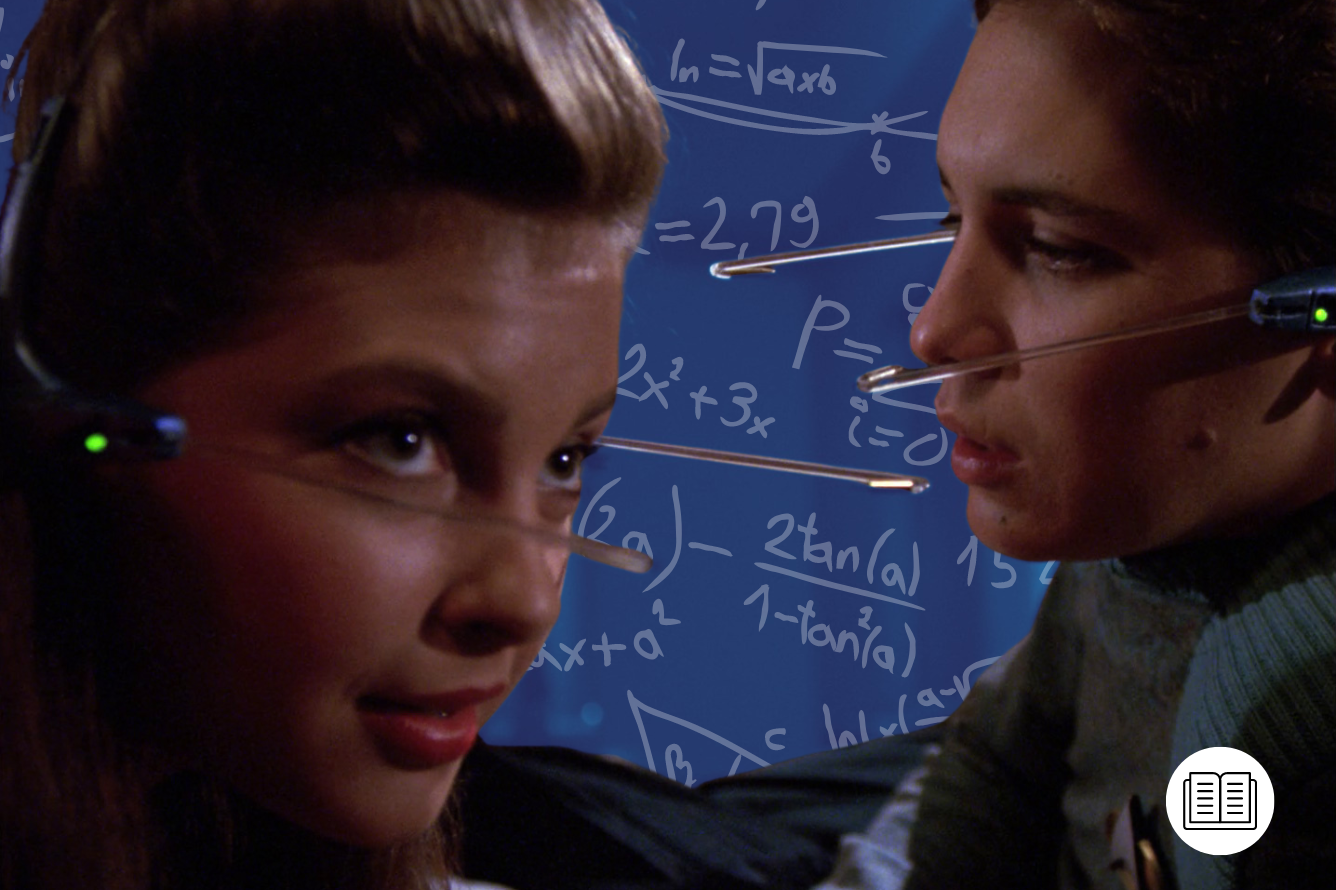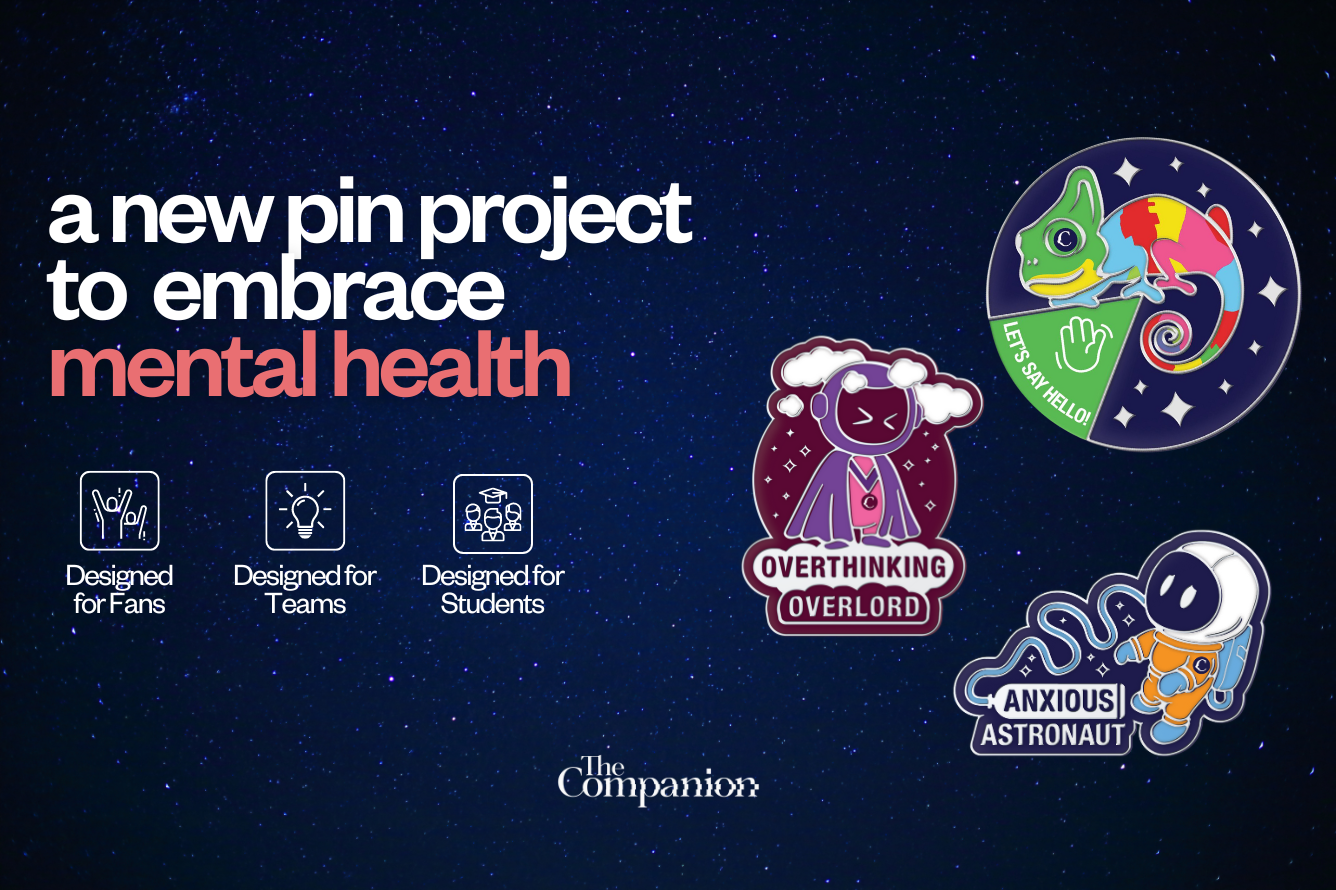For my money, the most sensual scene in the long history of Star Trek’s Will Riker (Jonathan Frakes) and Deanna Troi (Marina Sirtis) is when Counsellor Troi sits across from her Imzadi and describes not only her process but the specific levels of enjoyment she gets from the slow, methodical consumption of a chocolate sundae.
“It’s not just a matter of taste. It’s the whole experience,” she says, after detailing the ritual of spooning the fudge around the rim of the sundae glass and closing her eyes to make the most of the final euphoric bite, much to Will’s delight and curiosity.
This scene in the Star Trek: The Next Generation episode ‘The Game’ (S5, Ep6) is fitting because, at its smooth caramel center, this is an episode about pleasure. Where Troi’s idea of pleasure is rooted in feeling, tasting, and savoring an experience, Will promises something “better than chocolate”, a headset game from the hedonistic resort planet of Risa, which bypasses the senses entirely and engages the brain’s pleasure centers.
Viewers soon learn that although both kinds of pleasure might feel good, shortcutting the senses and getting your kicks from tech doesn’t always end well. It turns out the headset game wasn’t a gift from Riker’s holiday fling, the Ktarian Etana Jol (Katherine Moffat), but a highly-addictive device designed to seize control of the crew’s minds and, eventually, infiltrate Starfleet.

Shortly after Riker’s return to Enterprise with the game, almost everyone wanders around in a trance-like state while playing it – even famously fun-averse Captain Jean-Luc Picard (Patrick Stewart). It also tampers with their ability to think rationally, which leaves them susceptible to Etana’s commands.
Luckily, Wesley Crusher (Wil Wheaton) visits Enterprise during a break from Starfleet Academy, and he’s too preoccupied with his crush on Ensign Robin Lefler (Ashley Judd) to succumb to everyone’s peer pressure to try the game. Fast-forward to the end of the episode and as the crew pins Wesley down to force the game on him, Data (Brent Spiner) saves the day with a sequence of flashing lights to undo the game’s effects.
It’s an entertaining episode that’s also unnerving. Viewers never learn Etana’s grand plans, they watch beloved crew members act entirely out of character, and they’re forced to reckon with their own fears about technology and its potentially harmful effects – which is no surprise considering that’s why it was written.
Initially pitched by production associate and writer Susan Sackett and writer Fred Bronson, Bronson once said in an interview with cult TV magazine Starburst: “It was based on the fact that I had a Tetris game on my computer at home. Whenever I wanted to […] distract myself I would play Tetris and it was very addictive.”
Fast-forward 30 years, and I can confirm the sundae scene is just as enjoyable, and worries about the effects of tech and gaming are just as relevant. But what I want to know is whether advances in brain-reading tech and hardware design mean a wearable, pleasure-producing game like this could soon become a reality.
Brain-Computer Interface and Electroencephalography
The game is a headset device worn over the top of a player’s head, like a pair of headphones, with two arms that stick out at the front to project the game into their eyes only. The game begins with a disc, which the player must guide into a cup with only their mind. There are multiple levels (Nurse Ogawa reaches level 47) that add more discs and cups.
If you think this game sounds unexciting to have entranced crew members that regularly step onto the holodeck and into hyper-realistic virtual worlds, you’re not alone. According to the 1995 book Captains’ Logs: The Unauthorized Complete Trek Voyages, Jonathan Frakes said: “They told me it was going to be this incredible graphic, and all it was… was a tuba on a checkerboard.”

Corny visuals aside, is it possible to play this today? Anton Nijholt, a Professor in Human-Computer Interaction at the University of Twente, in the Netherlands, tells me similar tech is already in use.
“It’s very simple,” he explains. “It’s no problem to realize it [a version of the game] with BCI using a few electrodes that are attached non-invasively to your scalp that measure your brain waves.”
A BCI, or brain-computer interface, allows you to interact with a computer using only your brain – just like the game in Star Trek: The Next Generation – with a method called EEG (Electroencephalography). Electrical activity from your brain is measured and used as input for a game or app.
Marvin Andujar, Research Lab Director at the Neuro-Machine Interaction Lab and Assistant Professor at the University of South Florida, tells me there are several BCI games in development that challenge you to stay focused or relaxed. “This is what we’re calling neuro games,” he says.
Andujar’s team is currently developing a racing neuro game. “You can race other people or race yourself to beat your own time,” he explains. “It requires the gamer to be very focused and not distracted. At the moment, if the racer gets distracted, the other person can win by being highly focused.”

In ‘The Game’, the goal is relaxation. “You know what the secret is, don’t you? Don’t force it. If you just let the game happen, it almost plays itself,” Nurse Ogawa (Patti Yasutake) tells Wesley Crusher. But Nijholt suggests it could also work by imagining the disc moving into the cup and measuring activity from the motor cortex. “This change in signals can be communicated to the computer that translates it to a particular action in a game,” he explains.
Head-Hugging Hardware
Simple mind-powered games are possible, but do BCI devices look like the faux-futuristic headsets imagined in Star Trek: The Next Generation?
“Usually for BCI, a brain cap with many electrodes is used,” Nijholt explains. He says this depends on what you want to measure. Researchers need lots of electrodes for ambitious applications, but only a few for something simple.
This is how a few companies have been able to slim down the bulky tech used in labs. For example, the MindWave Mobile 2 from NeuroSky has meditation, learning, and gaming apps with a slim design that looks similar to the game from Star Trek: The Next Generation. Nijholt thinks the closest example is ear-BCIs. “Electrodes are embedded on a customized earpiece, as typically used in hearing aids.”
To play a neuro game, you need to wear a BCI and watch it on a separate display, like a computer screen. But is a built-in display possible to play games with your mind on the move?
One option is to add glasses to a headset and display the game on the lenses. Right now, this doesn’t exist. But it’s a similar design to augmented reality (AR) devices, which look like chunky glasses. You see the world through them, but virtual elements are added on a screen in front of you.
AR devices already exist, like the Microsoft Hololens 2 or the Vuzix Blade for businesses, but they’re not really aimed at consumers. However, industry experts believe AR and MR tech will become ubiquitous soon as big tech brands, like Meta and Apple, pump money into research and development. If you want to play a game in five years, you might reach for your AR specs rather than your console.
Shrink displays down even smaller, and you get the Mojo Lenses. These contact lenses have a tiny microLED display the size of a grain of sand, which shows information and possibly games in the future.
But Nijholt explains the game works differently by “projecting the video game directly on the retina, instead of on a computer screen or glasses.” This sounds like science fiction but has been in development for decades.
It’s called a virtual retinal display (VRD) and shines low-powered lasers onto your retina so you see a floating screen in front of you. Many companies, including Intel, Fujitsu, and Bosch, have created VRD prototypes, but there’s a long way to go before you’re able to ditch devices and beam your screens to your eyeballs instead.
Engineering Addiction
When Wesley Crusher and Robin Lefler realize something weird is going down, they analyze the game using the Enterprise’s computer. They find out it’s “psychotropically addictive” and “initiates a serotonin cascade in the frontal lobe of the brain.” Although this episode is rife with technobabble, is it possible to create pleasurable and even addictive experiences with BCIs?
“That’s difficult to imagine, and certainly not with such a simple set-up,” Nijholt says. However, he explains that adding a BCI element to a video game can be used to modify gameplay.
This all has to do with how you feel, which can be measured by looking at your brain activity.
“You can measure whether the game is too difficult (player becomes frustrated) or too easy (player shows disinterest) and this information can be used to adapt the game to the user.”
Adapting games isn’t likely to make a neuro game as addictive as the game in Star Trek: The Next Generation, but Nijholt says it could influence a player’s experience and emotions. This effect could be more pronounced if you take the tech worn on your head with a non-invasive BCI and implant it under your skull instead – an invasive BCI. These devices are mostly used to replace or restore functions to people with neuromuscular disorders, like spinal cord injury or stroke. However, many companies, including Elon Musk’s Neuralink, plan on further advancing this tech and making it more widely available.
Current examples of BCI – whether worn inside the skull or not – only work one way, by measuring signals from the brain. But there are ways to send a signal to the brain to stimulate it.
One example is Transcranial Direct Current Stimulation (tDCS), which disrupts specific brain processes by delivering small electrical currents. These have game applications to enhance cognition and memory. There have also been experiments to couple brains, which combine BCI to read one person’s brain activity and tDCS to replicate the activity in someone else. These applications are fascinating, but the tech is still in its infancy. “It is possible to experiment with them but it should be done for medical reasons only in very controlled environments,” Nijholt warns.
Although a lot of exciting brainwave-sensing tech is in development, it doesn’t mean we’ll soon be seeing brain implants to measure your brainwaves being sold alongside Fitbits to count your steps. “The ethical dubiousness of it means it would never happen,” Pete Etchells, a Professor of Psychology at Bath Spa University, video games researcher, and author of Lost in a Good Game: Why We Play Video Games and What They Can Do for Us, says.
“Even now, lots of people are worried that video games can be addictive, even without directly zapping our brains.”

This question of whether games and devices are already harmful is a point of contention. “Scientists are currently doing research looking into whether there are certain types of mechanisms within games that are psychologically comparable to gambling,” Etchells explains. “And in turn, whether they can result in behavioral addictions similar to gambling.”
He says researchers currently have little understanding of gaming addiction. It may not exist at all and if it does, it’s rare. “This isn’t something that the vast majority of players would need to worry about,” he explains.
Although many elements of the gaming headset in Star Trek: The Next Generation are already possible, what’s less clear is whether companies – or even malicious alien races – could one day use a device like this for nefarious purposes.
The experts I spoke to agreed the possibility of mind-controlling tech is pure science fiction, and the jury’s out about whether tech or gaming addiction even exists. But what about in the future? Given what we’ve learned about tech companies’ data-gathering and opinion-manipulating tactics in recent years, let’s stay on guard. I’d like to believe the biggest names in tech have better ethics boards than the Ktarians, but I won’t bet my replicator rations on it.
This article was first published on December 1st, 2021, on the original Companion website.
The cost of your membership has allowed us to mentor new writers and allowed us to reflect the diversity of voices within fandom. None of this is possible without you. Thank you. 🙂









